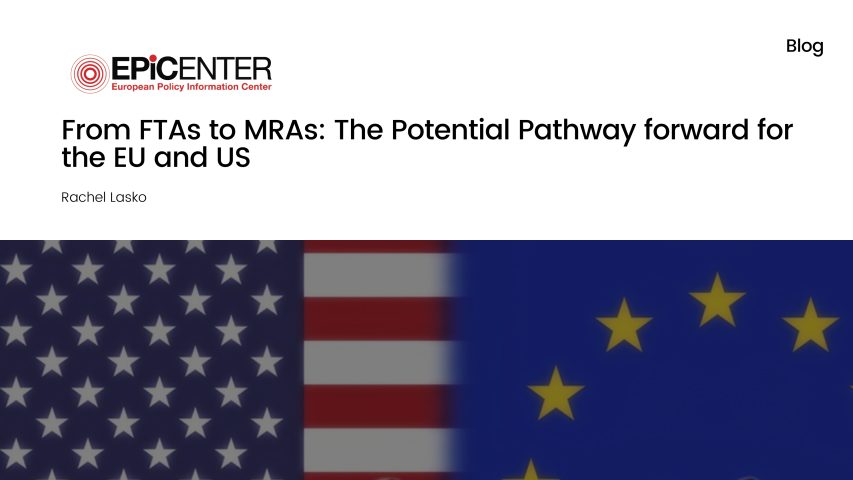From FTAs to MRAs: the Potential Pathway Forward for the EU and US

From FTAs to MRAs: the Potential Pathway Forward for the EU and US
Rachel Lasko // 14 April 2021
The United States lacks a comprehensive free trade agreement (FTA) with the EU, and the failed Transatlantic Trade and Investment Partnership (TTIP) negotiations during the Obama-era proved that there are significant barriers to achieving one. The TTIP negotiations shed a light on the specific barriers to free trade between the EU and US, highlighting issues of conflicting values and the complexity of trading amongst differing regulatory models. Even though the new Biden administration brings hope that there will be more EU-US cooperation, this administration will not be able to undo the complex trade tensions surrounding controversial areas unless one party decides to radically change their regulatory system or re-evaluate their national values. Not all hope is lost though, and the US should seek to negotiate Mutual Recognition Agreements (MRAs) in areas where there are shared EU-US interests and commitments.
The talk of mutual recognition agreements has gained a lot of attention in the media over the past few years, with MRAs being cited as a potential option to mitigate Brexit-related trade issues. One of the Brexit trade deal options was to opt for an ‘Australian-style’ deal which would foster trade with the EU utilising different tools, like MRAs, rather than trying to immediately reach a comprehensive free trade agreement. In practice, MRAs are used to recognise the equivalence of standards (inspection, testing, and certification requirements) between two countries in order to allow for the elimination of technical barriers to trade in a specific area and gain greater market access. Currently, the EU has MRAs with the United States in the areas of human medicines, EMC, telecommunication equipment and marine equipment, but there is a lot of opportunity for the use of MRAs to expand into areas where there are shared values and regulatory approaches.
In 2019, the EU and US celebrated great success in establishing the mutual recognition of inspections of medicine manufacturers, and such success has actually furthered the MRA dialogue between EU and US regulatory agencies during the coronavirus pandemic. The EU’s EMA and US’ FDA have continually worked together throughout the coronavirus pandemic to share their regulatory challenges and the MRA between the two established practices such as the two bodies sharing inspection reports to inform regulatory decisions like drug approvals. The coronavirus pandemic bound together the already familiar transatlantic regulatory agencies and strengthened bilateral relations between the EU and US. The area of human medicines is just one example of how an MRA has been implemented and successfully fostered shared know-how, collaboration, and R&D in the transatlantic relationship.
There are a lot of opportunities for the EU to engage and establish further MRAs with the United States, especially considering the new ambitions of the Biden administration. Both the EU and US have already expressed their shared desire to expand the MRA which touches on human medicines into including vaccines and addressing veterinary sciences. Other areas, like technology and environmental protection, where the EU plans to collaborate with the Biden administration, could likewise open up the doors to potential MRAs in the manufacturing and development of emerging technologies and green tech. The anticipated revamp to the transatlantic relationship presents the bilateral interest to find consensus and the potential to identify several areas where the recognition of standards between the EU and US can be found.
From a US perspective, the Biden Administration should not exhaust the time and energy focusing on areas of disagreement while negotiating a free trade agreement with the EU, but it should instead focus on identifying areas where there is an opportunity for agreement. Further, the EU and the US already have a few existing MRAs which have exhibited great success, so now it is a matter of refocusing on areas where transatlantic collaboration can be strengthened, and market access can be opened. If Biden’s goal is to have a stronger relationship with the EU, then he should prioritise recognising where the EU is aligned with US values and collaborate on opening up trade in those areas. The goal of the Biden Administration is to demonstrate that “America is Back” and to embolden its relationship with its allies — MRAs have the potential to bolster the cooperation with the EU, even if there will still be areas that continue to divide the EU and the US.
EPICENTER publications and contributions from our member think tanks are designed to promote the discussion of economic issues and the role of markets in solving economic and social problems. As with all EPICENTER publications, the views expressed here are those of the author and not EPICENTER or its member think tanks (which have no corporate view).



